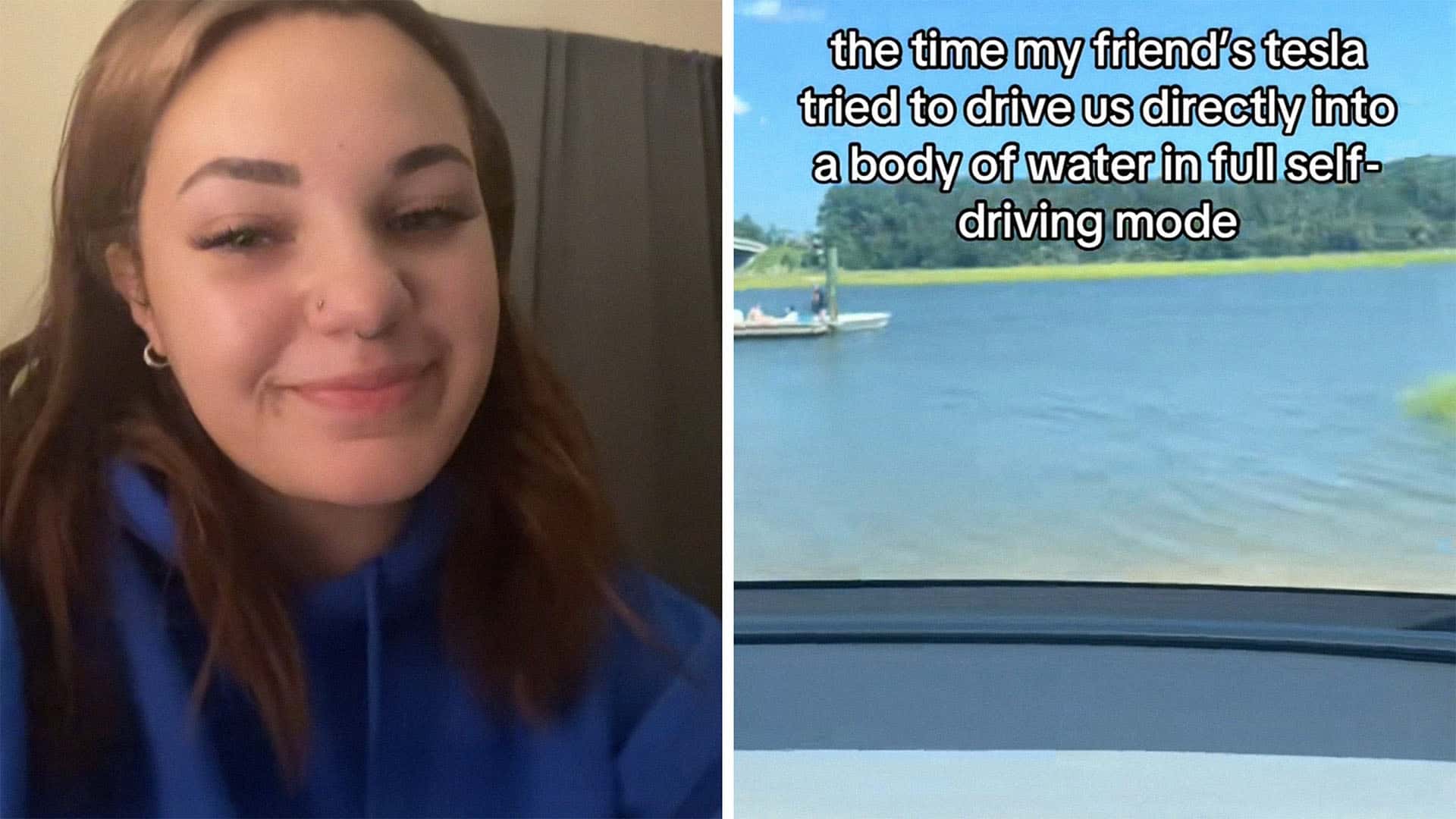A Tesla driver recorded their vehicle nearly ending up in a pond while allegedly operating in Full Self-Driving mode. TikTok user Olivia G. (@oliviagg16) posted a clip that shows the EV headed directly to what appears to be a river. As the car barrels toward the water, the person sitting in the Tesla’s driver’s seat ends up tapping on the screen, bringing it to a halt. Olivia penned in a caption for her post: “The car didn’t stop until he took over and hit the brake. We were almost in the water,” she shared.
If nothing else, it’s a stark reminder that Full Self-Driving requires constant human monitoring and a willingness to intervene if things go south, just as Tesla itself requires.
Tesla Full Self-Driving Into Water
There have been other Tesla owners who’ve relied on Full Self-Driving and gotten in trouble as a result. In 2023, Autoevolution wrote that a Model 3 purportedly careened directly into a pond with the Full Self-Drivingfull beta program engaged. In a YouTube video shared to the Wham Baam Teslacam page, footage from the vehicle’s dash cam shows it plunging headfirst into a mass of brown water.
After getting stuck, a man behind the wheel exited the vehicle from the front passenger’s window. Further details indicate the commuter was traveling in Mono City, California with the autonomous driving mode engaged. There were road signs indicating that flooding was occurring up ahead that the car’s camera- and AI-based system reportedly did not clock.
Subsequently, the car drove ahead at its set speed of 60 mph until it hit water that had gathered on the road. This caused the Model 3 to hydroplane until it veered left and off the road, crashing into a pond.
Following the incident, the Tesla owner expressed his dissatisfaction with the software’s inability to assess the safety hazards before it. He said he intended to sue both Tesla and the city for the accident, which Autoevolution suggested probably wasn’t to end well for the owner.
Tesla Self-Driving Lawsuits
On June 23, Reuters reported that Tesla was being sued over a crash involving a Model S equipped with Full Self-Drivingfull functionality. The accident reportedly resulted in the deaths of three people in September: David Dryerman, along with his wife Michele and their 17-year-old daughter, Brooke. According to the suit, which was filed in the federal court located in Camden, New Jersey, their deaths were attributed to the car’s “defective and unreasonably dangerous design,” Reuters wrote.
NPR covered another incident that occurred in Key Largo, Florida in April of 2019. The outlet writes that the driver had his Tesla Model S autopilot system initiated which he claims ran a stop sign. The vehicle slammed into a parked Chevrolet Tahoe, which tragically resulted in the death of 22-year-old Naibel Benavides Leon, who was standing beside the SUV. Dillon Angulo, who was also struck by the vehicle, sustained serious injuries. Leon’s body was launched 75 feet away from the scene of the collision.
Autopilot Deaths
The law firm of Halpern, Santos, and Pinkert went on to write that a “grieving family…filed a wrongful death lawsuit” against Tesla as well. On its website, the firm writes about a 33-year-old Californian who was also driving a Tesla Model S “in autopilot mode at approximately 71 mph for 12 minutes on Interstate 680.” While doing so, the car reportedly “collided with a parked fire truck blocking his lane.” Additionally, the legal team wrote that this person purchased his Model S due to its advertised Autopilot functionality.
Furthermore, another legal team, Sokolove Law, launched a class-action lawsuit against the electric vehicle manufacturer. The basis of the claims in the mass suit distinctly pertained to “Autopilot & self-driving malfunctions.” Also referenced in the claim is that “Tesla owners paid for technology that may not work properly.” Sokolove Law went on to claim Tesla engaged in “deceptive marketing” with regards to its full self-driving and Autopilot software.
Despite these aforementioned legal cases, there are great many Tesla enthusiasts who’ve praised the capabilities of the brand’s Full Self-Driving system. Like this one Uber driver InsideEVs reported on who finances multiple Teslas. He extolled the brand’s automated driving assistance (ADAS) features , and shared his plans for utilizing them in future plans to create a full self-driving fleet of vehicles.
Commenters Sound Off
Several folks who replied to Olivia’s video expressed their shock with the Tesla’s behavior in her posted TikTok. One user remarked, “Odd, it clearly shows it knows the road ends there on the map.”
Another remarked that they weren’t sold on the idea of full self-driving. “How do people feel safe in a car that is driving itself,” they wrote.
Someone else replied that Tesla’s decision not to implement Lidar technology or other sensors in its vehicles is what’s ultimately holding its Full Self-Driving capabilities back. “It’s cause they use camera detection (The worst kind) and not Lidar Scans (The best kind) Mark Rober made a video on it and Tesla went right through a painting of a road,” they replied.
Someone else argued that the infotainment system indicates the car was, in fact, not engaged in Full Self-Driving mode. “It’s not even on FSD…. it would have a blue line or rainbow road if it was,” they said. However, Olivia countered,stating that there was a full video showing that this was indeed the case. At the start of the unedited clip, the video shows Full Self-Driving engaged. The Tesla then makes a turn towards the water and heads directly toward it.
InsideEVs has reached out to Olivia via TikTok comment for further information.
